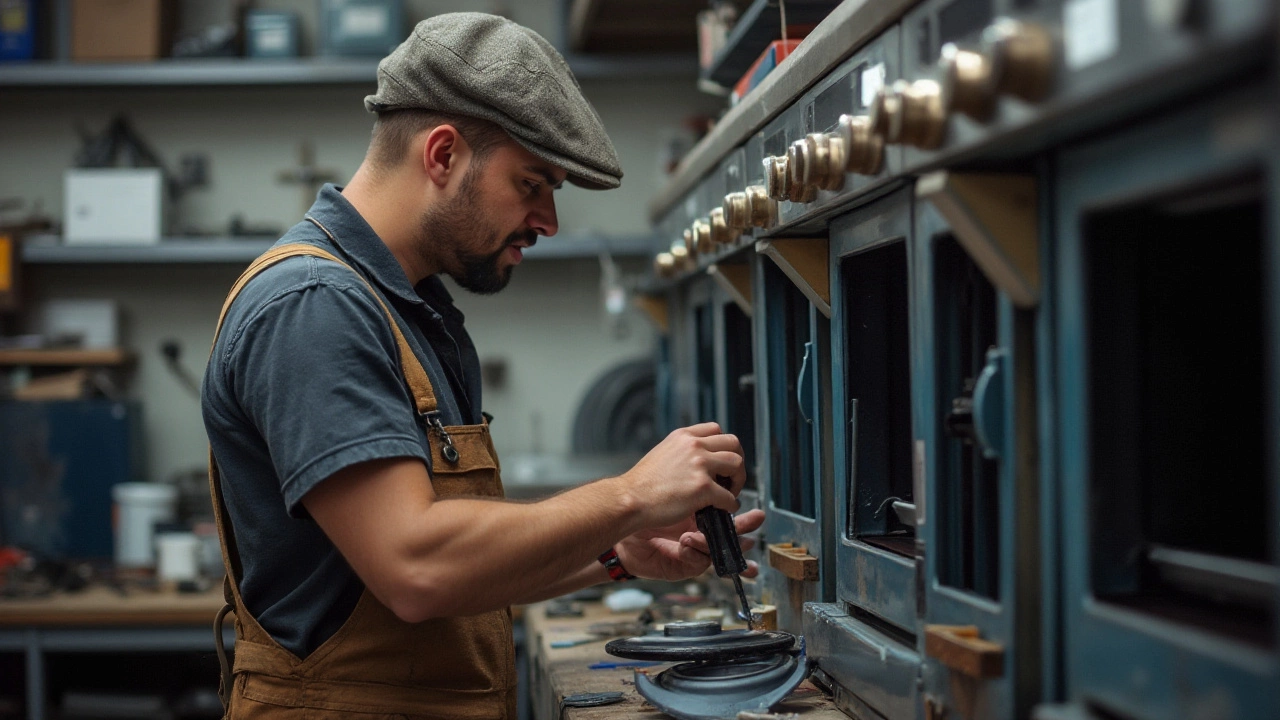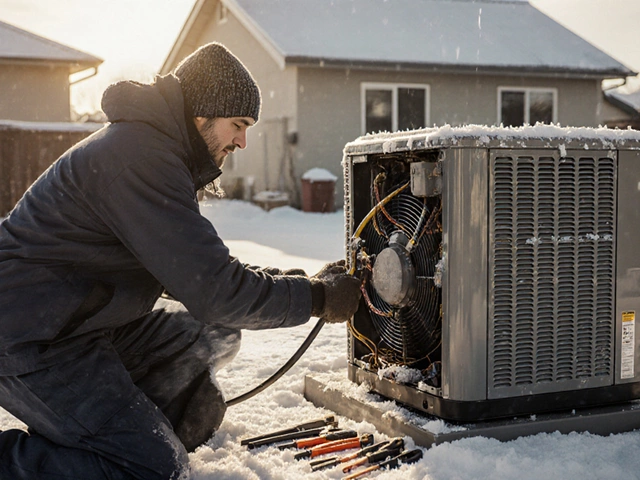Ovens hold a dear spot in our kitchens, turning uncooked ingredients into delightful meals. But like any other appliance, they are prone to breakdowns and malfunctions. Understanding the cost of fixing your oven can save you from being caught by surprise. After all, whether it's a minor glitch or a more substantial fault, it's good to know what's going into preparing your favorite shepherd's pie again.
In this piece, we'll dive into common issues that plague ovens and dissect the factors that contribute to the repair costs. You'll find a blend of insights if you're a do-it-yourself enthusiast or someone who prefers calling in the experts. Plus, we’ll sprinkle in some handy tips to keep those repairing costs in check and touch upon when it may be time to consider an upgrade instead.
- Common Oven Issues
- Factors Influencing Repair Costs
- DIY vs Professional Repair
- Average Repair Costs in New Zealand
- Tips for Reducing Repair Expenses
- When to Consider Replacement
Common Oven Issues
Ever noticed how the kitchen seems a little less welcoming when your oven isn’t pulling its weight? While these kitchen workhorses are renowned for their durability, they’re not immune to troubles. Let’s delve into some of the common ailments that can plague an oven. One of the most frequent issues homeowners encounter is an oven that refuses to heat up. This can be attributed to a faulty heating element or a damaged thermostat, both of which play a crucial role in regulating the temperature inside your oven. A non-heating oven isn’t just frustrating; it can put a serious damper on dinner plans.
Another notorious problem is uneven cooking, where one side of the dish is blissfully golden while the other remains pale and undercooked. This could be due to worn-out or malfunctioning oven fans, which are responsible for circulating heat evenly around the cavity. No one enjoys a half-baked pie, and this issue makes it nearly impossible to predict cooking times adequately. Additionally, odd smells emanating from the oven can stem from accumulated grease or faulty wiring, both of which demand prompt attention. In some cases, persistent odor issues might indicate a gas leak or a problem with the electrical system.
Advanced controls and digital displays on modern ovens can also introduce new challenges. If the control panel becomes unresponsive or starts showing error codes, it could leave you scratching your head trying to figure out what’s wrong. In times like this, flipping through the user manual can help, but sometimes a professional’s touch is needed to decode these cryptic messages. Robert Livingston, a seasoned technician, once said,
"Understanding appliance issues from the get-go can save you time and money in repairs."This is particularly true for recurring issues that might escalate over time.
Lastly, an oven door that doesn’t close properly is more than a slight annoyance. Whether it's due to a damaged seal or a misaligned hinge, this problem can lead to significant heat loss. This results in increased cooking times and higher energy consumption as the oven works overtime to maintain the desired temperature. All these issues combined with others make it clear that being able to identify the signals early on can make a significant difference in preventing minor problems from ballooning into expensive repairs. As with any appliance, regular maintenance can mitigate many of these common oven repair headaches, prolonging the life of your essential kitchen companion.
Factors Influencing Repair Costs
The costs associated with oven repair can vary significantly depending on several factors that might not be evident at first glance. One of the primary determinants is the type and severity of the problem. For instance, a faulty heating element or a malfunctioning thermostat typically carries a very different price tag compared to a blown-out fuse or damaged control board. Each part has its own cost and complexity of replacement, influencing the overall financial outlay.
Another crucial aspect is the make and model of your oven. High-end brands may employ proprietary parts that can be pricier and require specialized technicians. In contrast, more common brands usually have readily available components that are easier and cheaper to source. Consequently, repair work for extravagant models could see your budget straining more than anticipated. Coupled with this is the age of the appliance; newer models might still be covered under warranty, potentially cutting down your expenses significantly.
The geographical location where you reside also plays a pivotal role. Urban centers with more competition among repair services might offer better rates compared to rural areas, where options are limited and travel costs for technicians are higher. It's interesting to note that according to a study by Consumer NZ, repair rates can swing widely across regions, highlighting the need for obtaining multiple quotes before settling on a service provider.
The choice between DIY vs Professional Repair is another consideration when assessing cost. Tackling repairs yourself might seem like a robust way to save money, especially for straightforward fixes. Yet, it can be a double-edged sword if the problem is misdiagnosed or improperly handled, leading to heightened repair costs later when a professional has to fix the oversight. Expertise and experience count for much in these scenarios, often justifying the investment in a skilled technician.
An often overlooked factor is the time of the year. During festive seasons or holidays, service charges might creep upwards due to increased demand and fewer available technicians. Planning repairs during off-peak times can aid in cushioning your expenditures. As a rule of thumb, swift attention to minor issues can preclude them from escalating into costly repairs, providing a financial cushion for inevitable repairs when they do occur.
"A stitch in time saves nine," reminds James Morris, an acclaimed appliance repair specialist based in Auckland, "Tending to your appliances with regular checks can elongate their life and stave off unexpected big-ticket repairs."
In some instances, specific warranties or service contracts can also impact repair costs. Extended warranties sometimes cover major parts of the appliance, leaving only the labor costs to the owner. It's imperative to thoroughly review these agreements to comprehend what's encompassed and then leverage these warranties to curtail expenses effectively.

DIY vs Professional Repair
When your oven betrays you at the peak of your culinary creativity, the first instinct might be to roll up your sleeves and fix it yourself. Doing it yourself can certainly save you some bucks, and let's face it, there's a unique thrill in mastering your appliances. However, before you dive into DIY oven repair, consider whether you have the right tools and expertise. Common oven repair jobs might include replacing the heating element, fixing faulty wiring, or dealing with a broken door latch. Though these tasks can be simple in certain models, they can become daunting puzzles in others, especially if you lack technical know-how.
Should your troubleshooting lead you to a more intricate problem, don't shy away from admitting that a professional touch might be essential. By hiring a professional, you benefit from their intensive training and experience with potentially tricky oven repair issues. Another point to consider is the warranty of your appliance. Often, unauthorized DIY repairs can void warranties. Your time is precious, and sometimes the time invested in figuring out a fix could be better spent on other matters, like curating the perfect playlist for your upcoming dinner party.
In a survey conducted by the Sydney-based appliance support group, HomeFix, it was revealed that 65% of households who attempted DIY repairs ended up calling in a professional either immediately or eventually.
"It is always advisable to weigh the cost versus the potential risk when deciding whether to attempt a DIY repair," said John Simmons, a senior maintenance engineer from HomeFix, "understanding your limits can save you a lot of headaches."Putting your oven back on its feet may seem liberating, but make sure that it is not foolhardy.
To offer some perspective on potential costs, professional repair services might charge a call-out fee between NZD $60 and $100, plus labor and parts. If your issue is a simple fix like a sensor or thermostat replacement, labor might only cost an extra NZD $50-$70. However, if you’re facing more complex issues like electronic control or power supply malfunctions, budget for NZD $200-$400 including parts and labor. A staunch DIY fan might manage these repairs by sourcing parts at lower rates, but remember, playing with electricity always comes with its fair share of risk.
Whether you choose the DIY route or enlist professional help, ensure that the solution chosen is a safe and effective one. The middle ground can sometimes include seeking professional guidance online or bringing a knowledgeable friend into the mix. Just make sure that whomever you rely on knows their spark plugs from their heating elements and always prioritize safety above all else.
Average Repair Costs in New Zealand
When your trusty oven stops working, knowing what you might expect to shell out for repairs in New Zealand will arm you with the power to make decisions without feeling left in the dark. The cost spectrum for oven repair can vary widely, influenced not only by the type of issue but also by the specific model of your kitchen appliance. On the lower end, for minor faults like a faulty thermostat or a heating element replacement, you might be looking at anywhere from NZD 100 to 250. But if the problem lies deeper, perhaps in the electrical controls or with gas ovens, costs can quickly climb upwards of NZD 500.
Now, let's get into the granular details. The age of the oven plays a significant role; newer models potentially boast higher repair costs due to the complexity of technology and availability of parts. Older ovens might be simpler, but parts could be obsolete or on the costlier side due to rarity. Additionally, the brand is not to be underestimated. Popular brands might have easy-to-find parts, but premium brands will typically be associated with higher expenses. Occasionally, repairs can become uneconomical, enticing homeowners to contemplate replacement if the repair exceeds 50% of a new oven's cost.
"It's not uncommon for New Zealanders to weigh the cost of repairs against buying a new model, especially with the advancement in healthier and more efficient cooking technologies," says John Harris, a technician with over 20 years of experience in appliance repair.
Some residents in Auckland report paying a service call-out fee, which can range from NZD 80 to 150, just for the professional to arrive and diagnose the issue. This fee typically applies to the total cost if you proceed with their services but is crucial to factor into your burgeoning budget. Geographical location within New Zealand can also influence pricing — rural areas sometimes experience higher prices due to travel expenses for spare parts and trained technicians.
Let's not forget that there's always a tipping point. When is it worth fixing, and when should you consider throwing in the towel? A general rule of thumb to guide you is the 50% rule. Suppose the cost to repair is 50% or more of the price of a new oven with equivalent features. In that case, it is probably more economical to invest in a new one, especially if it's no longer under warranty.
Understanding these costs will help you manage repairs and align them with your budget realistically, ensuring you won't be caught off guard the next time your kitchen appliance decides to have issues while mid-roast.

Tips for Reducing Repair Expenses
Let's face it, no one wants a broken oven right in the midst of baking a delicious cake. A repair job often feels like it comes at the worst possible time, but getting smart about it can help ease the financial burden. One of the most effective ways to reduce repair costs is to carry out regular maintenance. Ovens accumulate grime and grease over time, clogging vents and sometimes causing elements to burn out faster than expected. Periodically deep cleaning your oven can help it run more efficiently, and potentially save you from shelling out big bucks when something fails.
"An ounce of prevention is worth a pound of cure." — Benjamin FranklinWhat if the fault is a bit more serious? Arm yourself with knowledge. Educate yourself about the common issues your oven model faces, be it a faulty thermostat or a broken heating element. By knowing this, you might be able to tackle minor issues yourself with some basic tools and save on labor costs. Resources like YouTube or forums are treasure troves of advice and guides tailored to specific models. Just ensure safety first—always disconnect your appliance from the power before doing any tinkering.
Another nifty tip is all about timing. When possible, try to schedule your oven repair when technicians offer discounted rates or during off-peak seasons. Some companies may offer lower prices during the slower months, which can stretch your budget further. Additionally, loyalty often pays. If you've used a repair service before, inquire if they offer any loyalty discounts for returning customers. It could be as simple as sending an email to their customer service team.
A word on parts—be smart with your purchases. When components need replacing, it's a good idea to source parts yourself if possible. While repair companies will have access to genuine parts, they often come with a markup. Plenty of reliable vendors online sell parts directly to consumers at a fraction of the cost. Remember to cross-check part numbers and ensure compatibility with your specific oven type. Sometimes extra effort saves money and that extra cash can be used for something more exciting, like new baking trays! Lastly, know when to draw the line. If repairs are becoming frequent or the costs are adding up to close to a new oven's price, it might be time to consider the economics of replacement. Weighing ongoing repair costs against a new purchase sometimes tilts the scale in favor of getting your kitchen a fresh start. As with most things in life, sometimes a new beginning is just what you need.
When to Consider Replacement
There comes a time when every trusty oven reaches the end of its road, and deciding when it's time for a replacement can be as crucial as fixing it. If your oven is spiraling with frequent breakdowns that never seem to find a permanent fix, that's a flashing sign it might be time for a new one. Throwing money into repair after repair can sometimes feel like trying to fix a sinking ship with duct tape. Additionally, if the repair estimates inch too close to half the price of a new oven, it might make more financial sense to invest in a more modern, efficient model. A new oven can also be a wiser choice if your existing one constantly fails energy efficiency standards as it can hike up your utility bills.
Modern ovens come equipped with advanced technology like air fry and smart settings that older models don’t boast off. These features not only enhance cooking efficiency but can also lead to savings in energy consumption. A report by the International Energy Agency illuminates that newer models can cut down energy usage by an impressive 20% compared to their older counterparts. A jump in energy prices might hasten this decision as investing in an energy-efficient model can save a hefty sum down the line. But not every breakdown warrants a new purchase; simple fixes like replacing a heating element may breathe a good few years back into your kitchen’s powerhouse.
Safety is paramount in any home, and a persistent smell of gas, unusual noises, or uneven cooking can signal potential hazards. In these cases, a replacement is not just a financial consideration but a safety one. Fixing such issues can present temporary solutions that may resurface, putting you and your loved ones at risk. As John Smith, a long-time appliance expert, aptly puts it,
"It's vital to weigh the risks of holding onto an aging oven. Sometimes, it's not just about the costs but ensuring safety and efficiency in your kitchen."
The final factor could be how long you've had your oven. The typical lifespan of an oven ranges from 10 to 15 years. If yours is approaching this mark, you may begin to notice performance decline, which can get frustrating. As ovens age, locating parts may become difficult, contributing to higher costs and longer repair times. Many reputable brands offer warranties and special deals for switching old models for new ones, making replacement a more attractive and sensible option.
Oven repair might seem daunting, but at times, it's essential to take a step back and look at the bigger picture. Weighing current inconvenience against future comfort and efficiency can be enlightening. By considering these aspects, you'll be better equipped to make a sound decision, ensuring that your time in the kitchen remains a pleasure, not a hassle.





